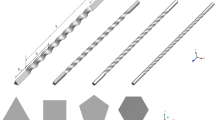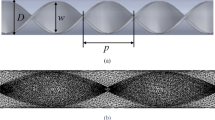Abstract
Twisted-tape tubes are commonly used in practice to passively enhance heat transfer. A clear understanding of the effect of variations in geometrical parameters as well as flow conditions is necessary, most importantly when it comes to finding the conditions in which the application of twisted-tape tubes is justifiable. The entropy generation analysis is a suitable approach towards defining such criteria. Therefore, in this paper, the effects of tube diameter, twist pitch, mass velocity, vapor quality, and saturation temperature are discussed in detail through entropy generation analysis. The Irreversibility Distribution Ratio (IDR) and Bejan number (Be), which track the variations of the components of total entropy generation, are discussed in each of these conditions. Finally, favorable conditions for using twisted-tape tubes rather than plain straight tubes are distinguished by defining entropy generation number (Ns). The results showed that twisted-tape tubes with bigger diameters have higher entropy generations. Also, increasing twist pitch and, similarly, increasing saturation temperature result in lower entropy generation. In addition, higher qualities lead to higher entropy generations and, finally, by increasing mass flux, entropy generation initially shows a drop and later a growth. The results for Ns show that employing twisted-tape tubes in lower mass velocities (roughly G ≤ 80 kg/m2s) and lower qualities (roughly x ≤ 0.4) and, as well as higher saturation temperatures (roughly Tsat ≥ − 18 ° C) is advantageous compared to plain straight ones.













Similar content being viewed by others
Abbreviations
- A :
-
Cross section (m2)
- L :
-
Length (m)
- D :
-
Tube diameter (mm)
- Y :
-
Twist ratio
- P :
-
Perimeter (m)
- dz :
-
Element discretization (m)
- G :
-
Mass velocity (kg. m−2. s−1)
- \( \overset{.}{m} \) :
-
Mass flow rate (kg. s−1)
- T :
-
Temperature (°C )
- x :
-
Vapor quality
- p :
-
Pressure (pa)
- q :
-
Heat flux (W. m−2)
- \( \overset{.}{Q} \) :
-
Heat rate (W)
- U :
-
Convective heat transfer coefficient (W. m−2. K−1)
- N s :
-
Entropy generation number
- Be :
-
Bejan number
- IDR :
-
Irreversibility distribution ratio
- h :
-
Specific enthalpy (J. kg−1)
- k :
-
Thermal conductivity (W. m−1K−1)
- c p :
-
Heat capacity (kJ. kg−1K−1)
- s :
-
Specific entropy (J. K−1)
- \( {\overset{.}{S}}_{gen}^{\prime } \) :
-
Total entropy generation per unit length (W. m−1. K−1)
- \( {\overset{.}{S}}_{\mathrm{gen}-\mathrm{ht}}^{\prime } \) :
-
Entropy generation per unit length due to heat transfer (W. m−1. K−1)
- \( {\overset{.}{S}}_{\mathrm{gen}-\mathrm{pd}}^{\prime } \) :
-
Entropy generation per unit length due to pressure drop (W. m−1. K−1)
- \( {\overset{.}{S}}_{\mathrm{gen}-\mathrm{tt}}^{\prime } \) :
-
Total entropy generation per unit length in twisted-tape tube (W. m−1. K−1)
- \( {\overset{.}{S}}_{\mathrm{gen}-\mathrm{st}}^{\prime } \) :
-
Total entropy generation per unit length in straight tube (W. m−1. K−1)
- ρ :
-
Density (kg. m3)
- v :
-
Specific volume (m3. kg−1)
- μ :
-
Dynamic viscosity (Ns. m−2)
- ht :
-
Heat transfer
- pd :
-
Pressure drop
- in:
-
Inlet
- l:
-
Liquid
- sat:
-
Saturation
- tp :
-
Two-phase
- v:
-
Vapor
- w:
-
Wall
References
Abdous MA, Holagh SG, Shamsaiee M, Saffari H (2019) The prediction of bubble departure and lift-off radii in vertical U-shaped channel under subcooled flow boiling based on forces balance analysis. Int J Therm Sci 142:316–331. https://doi.org/10.1016/j.ijthermalsci.2019.04.021
Guo J, Fan A, Zhang X, Liu W (2011) A numerical study on heat transfer and friction factor characteristics of laminar flow in a circular tube fitted with center-cleared twisted tape. Int J Therm Sci 50:1263–1270
Esmaeilzadeh E, Almohammadi H, Nokhosteen A, Motezaker A, Omrani AN (2014) Study on heat transfer and friction factor characteristics of γ-Al2O3/water through circular tube with twisted tape inserts with different thicknesses. Int J Therm Sci 82:72–83. https://doi.org/10.1016/j.ijthermalsci.2014.03.005
Song X, Dong G, Gao F, Diao X, Zheng L, Zhou F (2014) A numerical study of parabolic trough receiver with nonuniform heat flux and helical screw-tape inserts. Energy 77:771–782. https://doi.org/10.1016/j.energy.2014.09.049
Reid RS, Pate MB, Bergles AE (1991) A comparison of augmentation techniques during in-tube evaporation of R-113. J Heat Transf 113:451. https://doi.org/10.1115/1.2910582
Liu P, Zheng N, Liu Z, Liu W (2019) Thermal-hydraulic performance and entropy generation analysis of a parabolic trough receiver with conical strip inserts. Energy Convers Manag 179:30–45. https://doi.org/10.1016/j.enconman.2018.10.057
Qi C, Wang G, Yan Y, Mei S, Luo T (2018) Effect of rotating twisted tape on thermo-hydraulic performances of nano fl uids in heat-exchanger systems. Energy Convers Manag 166:744–757. https://doi.org/10.1016/j.enconman.2018.04.086
Woei S, Hui M (2012) International journal of heat and mass transfer thermal performances of enhanced smooth and spiky twisted tapes for laminar and turbulent tubular flows. Int J Heat Mass Transf 55:7651–7667. https://doi.org/10.1016/j.ijheatmasstransfer.2012.07.077
Eiamsa-ard S, Wongcharee K, Eiamsa-ard P, Thianpong C (2010) Heat transfer enhancement in a tube using delta-winglet twisted tape inserts. Appl Therm Eng 30:310–318. https://doi.org/10.1016/j.applthermaleng.2009.09.006
Eiamsa-Ard S, Somkleang P, Nuntadusit C, Thianpong C (2013) Heat transfer enhancement in tube by inserting uniform/non-uniform twisted-tapes with alternate axes: effect of rotated-axis length. Appl Therm Eng 54:289–309. https://doi.org/10.1016/j.applthermaleng.2013.01.041
Akhavan-Behabadi MA, Kumar R, Mohammadpour A, Jamali-Asthiani M (2009) Effect of twisted tape insert on heat transfer and pressure drop in horizontal evaporators for the flow of R-134a. Int J Refrig 32:922–930. https://doi.org/10.1016/j.ijrefrig.2008.11.004
Akhavan-Behabadi MA, Kumar R, Jamali M (2009) Investigation on heat transfer and pressure drop during swirl flow boiling of R-134a in a horizontal tube. Int J Heat Mass Transf 52:1918–1927. https://doi.org/10.1016/j.ijheatmasstransfer.2008.09.034
Kanizawa FT, Ribatski G (2012) Two-phase flow patterns and pressure drop inside horizontal tubes containing twisted-tape inserts. Int J Multiphase Flow 47:50–65. https://doi.org/10.1016/j.ijmultiphaseflow.2012.07.003
Mogaji TS, Kanizawa FT, Bandarra Filho EP, Ribatski G (2013) Experimental study of the effect of twisted-tape inserts on flow boiling heat transfer enhancement and pressure drop penalty. Int J Refrig 36:504–515. https://doi.org/10.1016/j.ijrefrig.2012.10.008
Zhu G, Bi Q, Cai L, Yan J, Lv H (2018) Subcooled flow boiling heat transfer of water in a circular channel with a twisted tape insert under high and non-uniform heat fluxes. Appl Therm Eng 138:722–730. https://doi.org/10.1016/j.applthermaleng.2018.04.040
Zhang X, Liu Z, Liu W (2012) Numerical studies on heat transfer and flow characteristics for laminar flow in a tube with multiple regularly spaced twisted tapes. Int J Therm Sci 58:157–167
Abdous MA, Holagh SG, Saffari H (2018) Numerical investigation of flow boiling heat transfer in helically coiled tube under constant heat flux. Therm Sci Eng 1. https://doi.org/10.24294/tse.v1i2.375
Kumar CN, Ilangkumaran M (2018) Experimental study on thermal performance and exergy analysis in an internally grooved tube integrated with triangular cut twisted tapes consisting of alternate wings. Heat Mass Transf:1–15. https://doi.org/10.1007/s00231-018-2484-2
Bejan A, Pfister PA (1980) Evaluation of heat transfer augmentation techniques based on their impact on entropy generation. Lett Heat Mass Transf 7:97–106. https://doi.org/10.1016/0094-4548(80)90037-5
Mwesigye A, Bello-Ochende T, Meyer JP (2016) Heat transfer and entropy generation in a parabolic trough receiver with wall-detached twisted tape inserts. Int J Therm Sci 99:238–257. https://doi.org/10.1016/j.ijthermalsci.2015.08.015
Kock F, Herwig H (2005) Entropy production calculation for turbulent shear flows and their implementation in cfd codes. Int J Heat Fluid Flow 26:672–680. https://doi.org/10.1016/j.ijheatfluidflow.2005.03.005
Collado FJ (2001) The entropy balance for boiling flow. Fusion Eng Des 56–57:199–203. https://doi.org/10.1016/S0920-3796(01)00259-9
Lin WW, Lee DJ, Peng XF (2001) Condensation performance in horizontal tubes with second-law consideration. Int J Energy Res 25:1005–1018. https://doi.org/10.1002/er.737
Collado FJ (2005) The law of stable equilibrium and the entropy-based boiling curve for flow boiling. Energy 30:807–819. https://doi.org/10.1016/j.energy.2004.04.007
Eskin N, Deniz E Influence of design parameters on two-phase pressure drop and entropy generation during evaporation of refrigerants. ECOS 2009 - 22nd Int Conf Effic cost, Optim Simul environ impact energy Syst, vol 2009, pp 159–168
Revellin R, Lips S, Khandekar S, Bonjour J (2009) Local entropy generation for saturated two-phase flow. Energy 34:1113–1121. https://doi.org/10.1016/j.energy.2009.03.014
Revellin R, Bonjour J (2011) Entropy generation during flow boiling of pure refrigerant and refrigerant-oil mixture. Int J Refrig 34:1040–1047. https://doi.org/10.1016/j.ijrefrig.2011.01.010
Abdous MA, Saffari H, Barzegar Avval H, Khoshzat M (2016) The study of entropy generation during flow boiling in a micro-fin tube. Int J Refrig 68:76–93. https://doi.org/10.1016/j.ijrefrig.2016.04.008
Abdous MA, Holagh SG, Shamsaiee M (2017) An evaluation of heat transfer enhancement technique in flow boiling conditions based on entropy generation analysis : micro-fin tube. 4th Int. Electron. Conf. Entropy its Appl, vol 4, pp 1–9. https://doi.org/10.3390/ecea-4-05002
Abdous MA, Saffari H, Avval HB, Khoshzat M (2015) Investigation of entropy generation in a helically coiled tube in flow boiling condition under a constant heat flux. Int J Refrig 60:217–233. https://doi.org/10.1016/j.ijrefrig.2015.07.026
Faghri A, Zhang Y (2006) Transport phenomena in multiphase systems. Elsevier, Burlington
American Society of Heating R and ACE (2001) ASHRAE handbook of fundamentals. ASHRAE, New York
Kanizawa FT, Mogaji TS, Ribatski G (2014) Evaluation of the heat transfer enhancement and pressure drop penalty during flow boiling inside tubes containing twisted tape insert. Appl Therm Eng 70:328–340. https://doi.org/10.1016/j.applthermaleng.2014.05.029
Kanizawa FT, Hernandes RS, De Moraes AAU, Ribatski G (2011) A new correlation for single and two- phase flow pressure drop in round tubes with twisted-tape inserts. J Braz Soc Mech Sci Eng XXXIII:243–250. https://doi.org/10.1590/s1678-58782011000500006
Kanizawa FT, Mogaji TS, Ribatski G (2016) A new model for flow boiling heat transfer coefficient inside horizontal tubes with twisted-tape inserts. Int J Refrig 61:55–68. https://doi.org/10.1016/j.ijrefrig.2015.09.003
Gungor KE, Winterton RH (1987) A general correlation for saturated flow boiling and comparison of correlations with data. Chem Eng Res Des 65:148–156
Author information
Authors and Affiliations
Corresponding author
Ethics declarations
Conflict of interest
On behalf of all authors, the corresponding author states that there is no conflict of interest.
Additional information
Publisher’s note
Springer Nature remains neutral with regard to jurisdictional claims in published maps and institutional affiliations.
Appendices
Appendix 1: The heat transfer coefficient correlations for the twisted-tape and plain straight tubes
Akhavan-Behabadi et al. [12]. correlated their experimental data in heat transfer coefficient in a Twisted-tape tube as Eq. (25):
Where hs is the two-phase heat transfer coefficient for Twisted-tape tube. Refo, Bo and Y are Reynolds number, Boiling number and twist ratio and are defined as Eqs. (26), (27) and (28) respectively.
In Eq. (25), hp is the two-phase heat transfer coefficient for plain straight tube. Akhavan-Behabadi et al. [12] used Gungor and Winterton’s [36] correlation to obtain hp as Eq. (29):
Where x is the vapor quality and the value of hf is calculated by Eq. (30) as follows:
Ref in Eq. (30) is the liquid Reynolds number and is given as Eq. (31):
In this study, Eqs. (25) and (29) were used to compute the heat transfer contribution to entropy generation in twisted-tape and plain straight tubes, respectively.
Appendix 2: The frictional pressure drop correlations for twisted tape and plain straight tubes
Equation (32) is suggested by Akhavan-Behabadi et al. [13] to calculate pressure drop for the Twisted-tape tube.
Where ∆Ps and Y are frictional pressure drop for the Twisted-tape tube and twisted tape ratio respectively. (∆Pf)Friedel is the frictional pressure drop for flow boiling in plain straight tube and obtained by the use of Friedel method.
In order to calculate the frictional pressure drop contribution to entropy generation in the twisted-tape and plain straight tubes, Eq. (32) and Friedel method were used respectively.
Rights and permissions
About this article
Cite this article
Holagh, S.G., Abdous, M.A., Shamsaiee, M. et al. Assessment of heat transfer enhancement technique in flow boiling conditions based on entropy generation analysis: twisted-tape tube. Heat Mass Transfer 56, 429–443 (2020). https://doi.org/10.1007/s00231-019-02705-y
Received:
Accepted:
Published:
Issue Date:
DOI: https://doi.org/10.1007/s00231-019-02705-y




